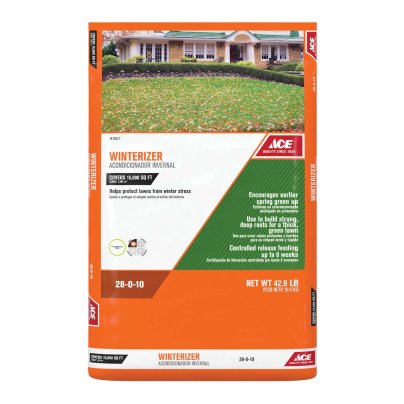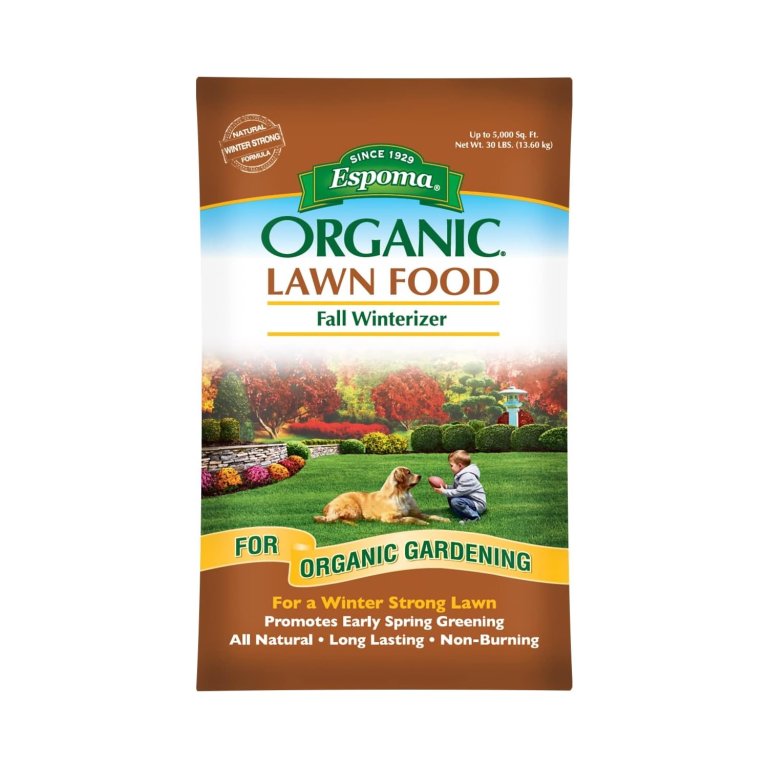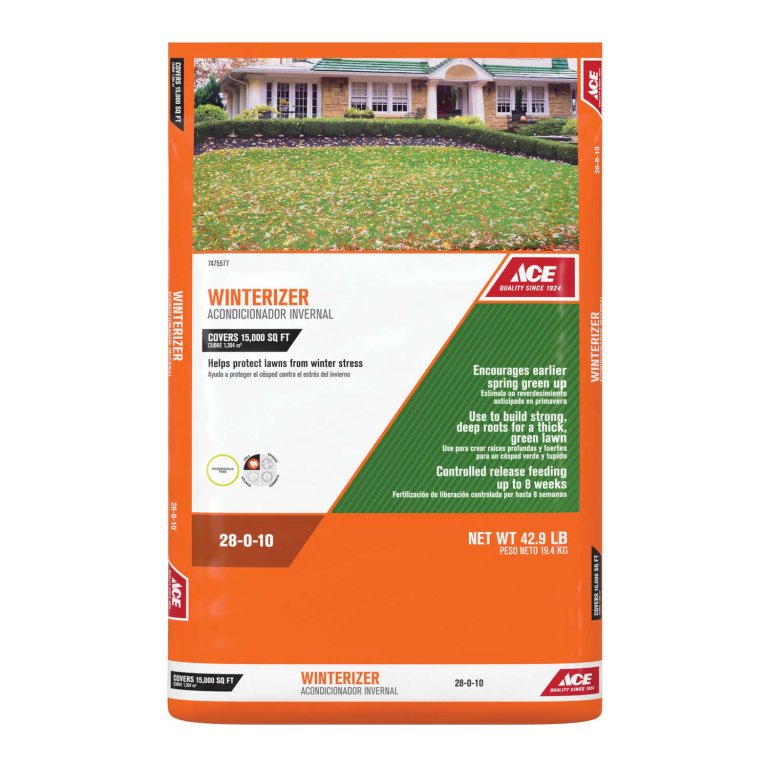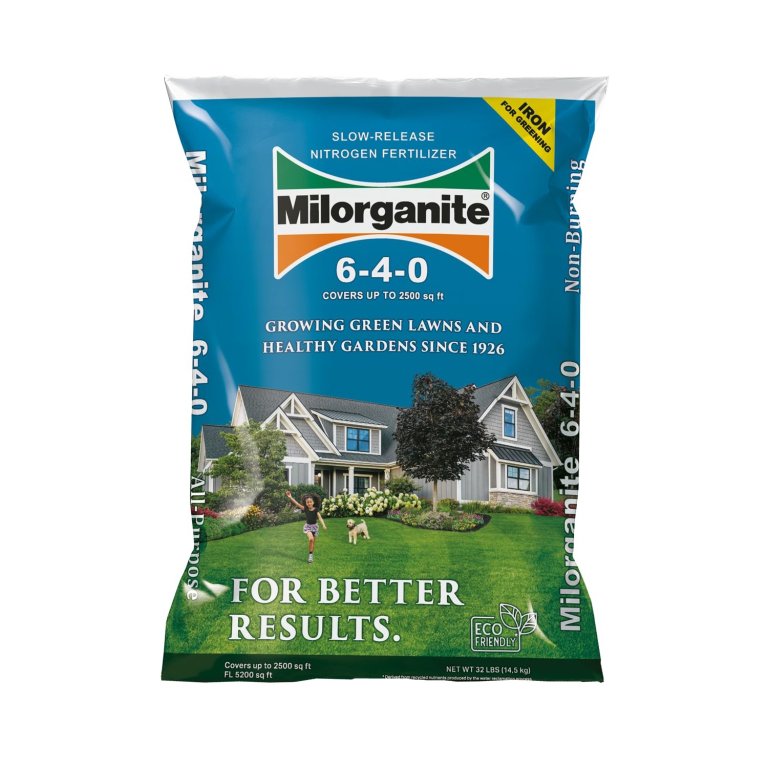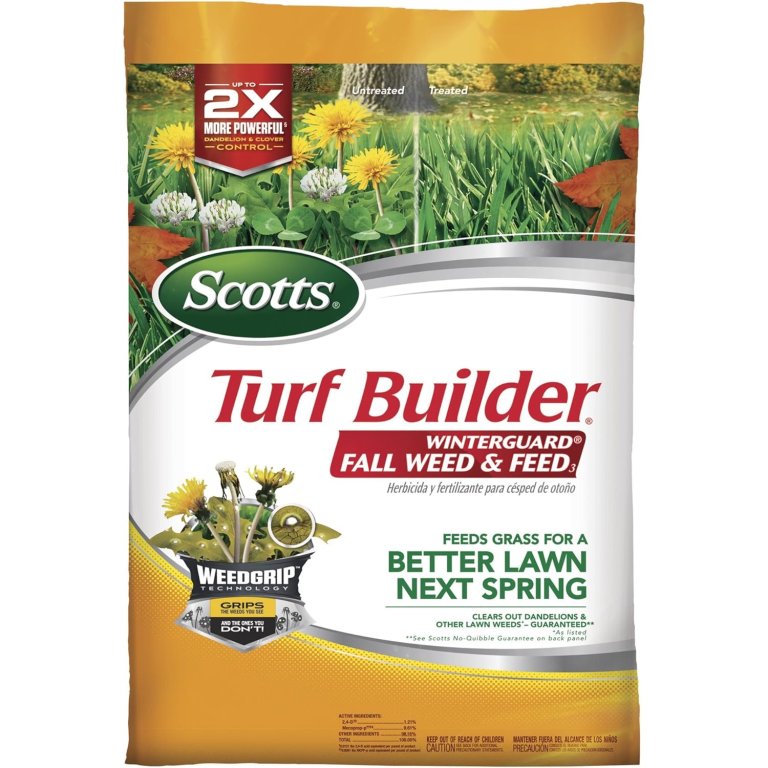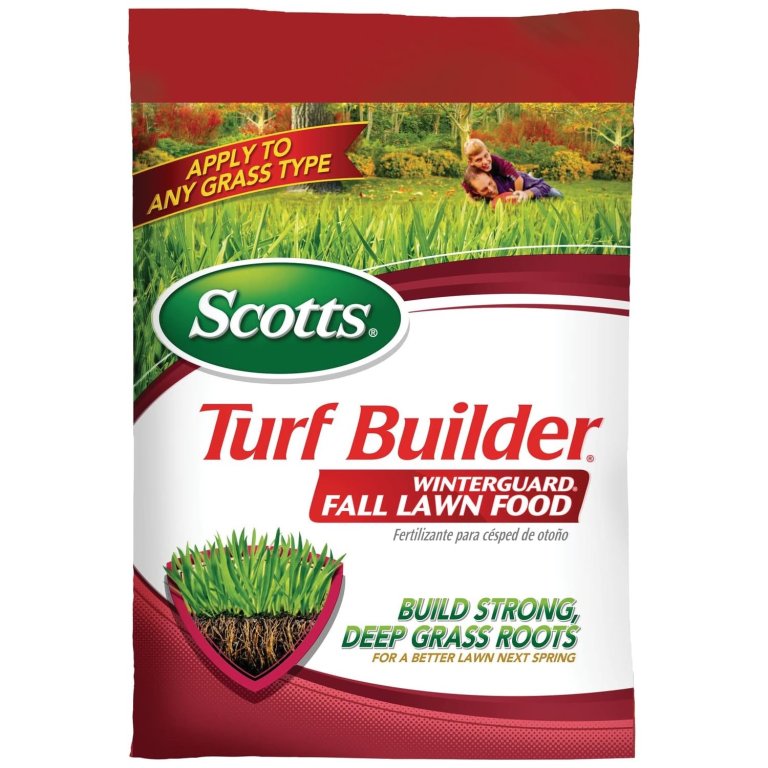
We may earn revenue from the products available on this page and participate in affiliate programs. Learn More ›
Summer takes a toll on lawns, but winter grass fertilizers help them grow new roots and green up in spring. Don’t let the name fool you. Winter fertilizers are applied in fall. They contain three macronutrients for grass health—nitrogen, phosphorus, and potassium—but the percentages can vary. These percentages are shown on fertilizer bags or labels as the NPK ratio. (For more detailed information on NPK ratio, read the section Nutrients that appears below our product reviews.)
Lawns need different kinds of fertilizers depending on the season and the type of grass. For cool-season grasses like Kentucky bluegrass, bent grass, ryegrass and fescues, shoppers will want to choose a winter fertilizer with a high percentage of nitrogen and a little potassium. Warm-season grasses, including St. Augustine, Bermuda, centipede, zoysia, and carpet grass, need one high in potassium but little or no nitrogen.
The best time to fertilize your lawn with a winter fertilizer is when the grass is starting to go dormant but it’s still green. A winter fertilizer can add or restore nutrients and help your lawn withstand harsh winter conditions, pests, and diseases. (When your grass starts actively growing again, switch to one of the lawn fertilizers.) After researching more than 20 winter grass fertilizers, we found these to be the best of the bunch. Here are our picks for the best winter grass fertilizers as well as pros and cons to consider.
- BEST OVERALL: Espoma Organic Lawn Food Fall Winterizer
- BEST BANG FOR THE BUCK: Ace Winterizer All-Purpose Lawn Fertilizer
- BEST ALL-PURPOSE: Milorganite 6-4-0 Slow-Release Nitrogen Fertilizer
- BEST FOR ZERO PHOSPHORUS: Purely Organic Products Lawn Food 10-0-2
- BEST WEED AND FEED: Scotts Turf Builder WinterGuard Fall Weed and Feed
- BEST SYNTHETIC: Scotts Turf Builder WinterGuard Fall Lawn Food
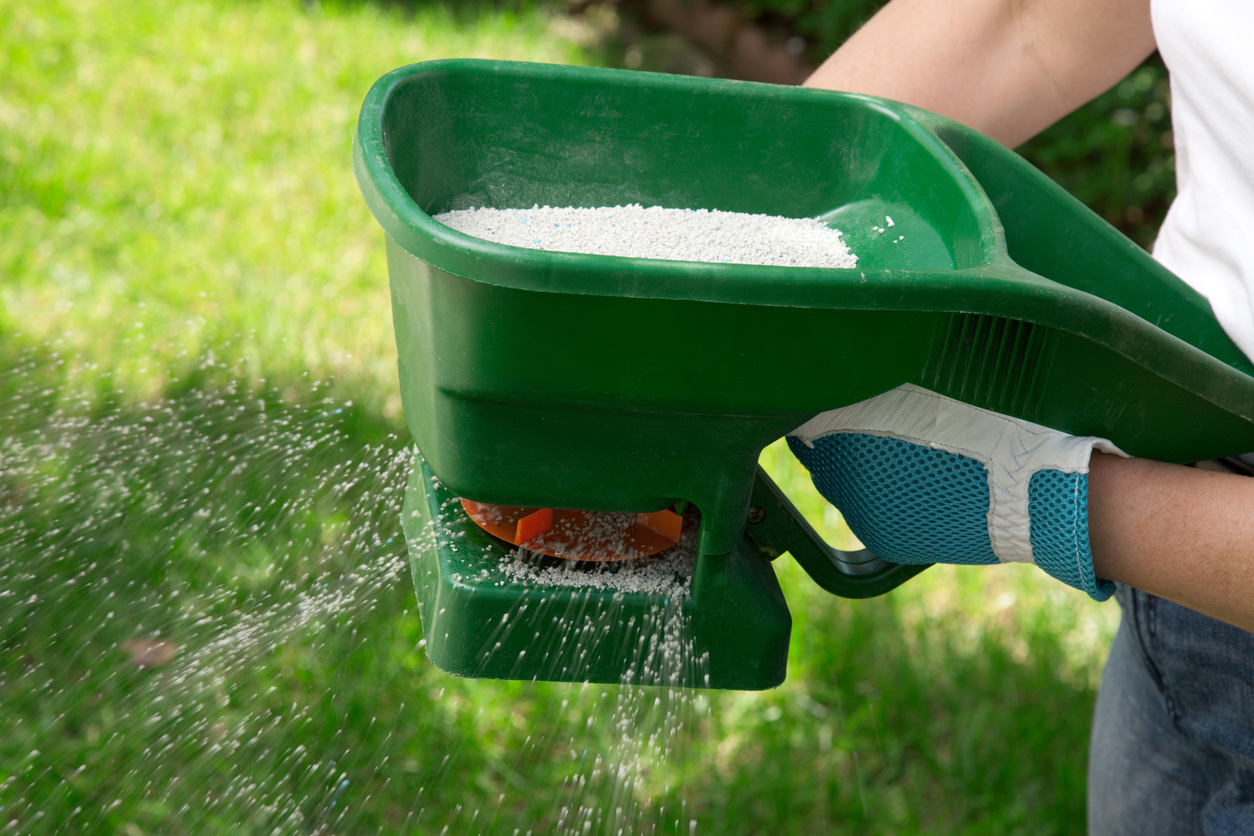
Before You Buy a Winter Grass Fertilizer
Before you go shopping, use a soil test kit or send a soil sample to your local extension service and tell them what type of grass you’re growing. Extension service offices work with state universities to provide expert advice on local soils, pests, fertilizers, and more. Their soil test results reveal how much and which nutrients your lawn needs.
Some states and municipalities prohibit or limit the use of nitrogen and phosphorus in lawn fertilizers because they can wash off into waterways and cause an overgrowth of algae and other water plants. These decrease the oxygen in the water that fish and other aquatic life need to survive. However, for those whose lawns need phosphorus but can’t use it, organics like rabbit, chicken, or duck manure; biochar, a charcoal-like material made by burning organic materials; or compost may be adequate alternatives. Green manure (crops that are specifically grown to be plowed under while they’re still green) can also add organic material to the soil.
Nitrogen gives the lawn carbohydrates to feed it through the winter and spring. However, nitrogen can combine with oxygen to form nitrous oxide, a gas that contributes to global warming. Nitrogen can also get into waterways, causing surface and ground-level pollution. Some states regulate the sale and/or use of nitrogen in lawn fertilizer by restricting the contents of the fertilizer sold and/or the application rates of nitrogen per 1,000 square feet of lawn.
How We Chose the Best Winter Grass Fertilizers
We researched more than 20 winter grass fertilizers based on user reviews, price, nutrients, and risk of fertilizer burn. We explored winter fertilizers that can be used on newly seeded or sodded lawns and those that can only be used on established lawns.
We examined organic and natural fertilizers versus inorganics, also called synthetic or traditional fertilizers. Organics can perform as well as inorganics, improve soil health, are nonburning, and are generally considered safe and environmentally friendly. However, they may take longer to work and are often more expensive. Results from any fertilizer can vary depending on the weather, soil, type of grass, and other factors.
Our Top Picks
Healthy, strong lawns need a quality winter lawn fertilizer to withstand the cold weather and grow vigorously in spring. Read on to find out why these are among the best winter lawn fertilizers.
Best Overall
Espoma Organic Lawn Food Fall Winterizer
Pros
- Certified-organic ingredients won’t burn lawns
- Safe for pets, people, and the environment when used as directed and stored out of reach of pets and children
- Won’t leach out of soil (wash away) from rain or irrigation
Cons
- Twice as much product is needed on a lawn if grass clippings are removed
Product Specs
- NPK ratio: 8-0-5
- Quantity: 30 pounds
- Coverage: 5,000 square feet
Made of natural and organic ingredients, including feather meal, poultry manure, and slow-release nitrogen, this Espoma lawn food fortifies lawns for the winter to help them grow dense and green up early in spring. It contains extra potassium to help lawns suffering from the summer stresses like foot traffic and drought, along with sulfur, which helps regulate soil pH. Espoma’s lawn food is eco-friendly and nonburning, so it won’t leach out of the soil and into waterways and users don’t have to worry about overfertilizing.
This long-lasting phosphate-free product can be used on any type of turfgrass as well as on newly sodded, newly seeded, or established lawns. Users will want to apply it when the lawn is dry and freshly mowed.
Get the Espoma winter grass fertilizer at Amazon, Walmart, or Espoma.
Best Bang For The Buck
Ace Winterizer All-Purpose Lawn Fertilizer
Pros
- Phosphorus-free so it can be used in municipalities that restrict phosphates
- Controlled-release feeding up to 8 weeks; as a result, users don’t have to reapply frequently
- Compatible for use on all established lawns, including mixed-grass lawns
Cons
- Use only on established lawns, not newly sodded or newly seeded lawns
Product Specs
- NPK ratio: 28-0-10
- Quantity: 42.9 pounds
- Coverage: 15,000 square feet
Despite its Winterizer name, this all-purpose nonorganic fertilizer can be used on any kind of turfgrass while the grass is actively growing. However, when used for fall feeding, this phosphorous-free product helps grass green up earlier in spring. It encourages vigorous, late-season root growth so lawns can better withstand heat and drought in the coming summer.
To reap the benefits of a fall feeding with this Ace fertilizer, warm-season grasses such as Bermuda, zoysia, St. Augustine, centipede, and Bahia require an early fall application. Cool-season grasses, like fescue, bluegrass, bent grass and ryegrass, can be fertilized with this product from early to late fall. Though this fertilizer can only be applied to established grass, not sod or newly seeded lawns, it’s still a great lawn care bargain, at about half the cost of similar products.
Get the Ace winter grass fertilizer at Ace Hardware.
Best All-Purpose
Milorganite 6-4-0 Slow-Release Nitrogen Fertilizer
Pros
- Slow release of nutrients decreases risk of product runoff
- Feeds lawns, flowers, vegetables, trees, and shrubs for 8 to 10 weeks
- Safe for use around pets and children when used as directed and stored out of reach
- Works indefinitely if stored properly in a cool, dry place
Cons
- Some users dislike the odor until it dissipates with rainfall or watering
- Nontoxic, but dogs should be kept off the lawn for 24 hours after application
- Nutrient percentages may fluctuate due to changes in wastewater, but the NPK ratio guarantees a minimum of each nutrient in the product
Product Specs
- NPK ratio: 6-4-0
- Quantity: 32 pounds
- Coverage: 2,500 square feet
Milorganite not only feeds lawns, but it also fertilizes trees, flowers, vegetables, and shrubs, making it a great all-in-one option. This 85 percent organic slow-release nitrogen fertilizer is made from naturally occurring microbes that are heat dried after they eat the organic materials in wastewater.
The manufacturer, Milwaukee Metropolitan Sewerage District, adds microbes to wastewater from the metropolitan Milwaukee area. After the microbes have digested the solids, the cleaned water goes back to Lake Michigan, and what’s left over is dried and formed into fertilizer pellets.
Milorganite contains virtually no salts (so grass is much less likely to burn), does not need to be watered in, and can be used as a carrier when you spread grass seed. This nontoxic fertilizer is also safer than many other lawn care products to use around children and pets (when used as directed), as it does not contain pesticides or herbicides. However, it can irritate dogs’ stomachs if consumed, so they should be kept off the lawn for 24 hours after application.
Get the Milorganite winter grass fertilizer at Amazon, Lowe’s, Ace Hardware, or The Home Depot.
Best For Zero Phosphorus
Purely Organic Products Lawn Food 10-0-2
Pros
- Contains no phosphates, so suitable for use in areas where they are banned
- Does not contain manure or biosolids; it does not emit unpleasant odors
- Does not burn grass when used as directed
- Can be used before or after seeding and in spring, summer, or fall
- No time restrictions on when users can reenter their lawn
Cons
- Some users may not like the slight beer smell due to the use of distillers’ grains
- Nitrogen restrictions in Florida may limit product usage; see bag for appropriate use
- Not for use on organic crops or organic food products
Product Specs
- NPK ratio: 10-0-2
- Quantity: 15 pounds, 25 pounds, and 40 pounds
- Coverage: 3,000 square feet; 6,250 square feet; and 10,000 square feet
Made from natural, plant-based ingredients like distillers’ dried grains and soybean meal, this fertilizer does not contain biosolids, manure (which can often make for stinky fertilizers), or harsh chemicals. It’s phosphate-free and delivers 2 percent potassium to help prevent winter diseases and promote grass health.
Suitable for all grass types in deep shade or in a combination of sun and shade, Purely Organic Products lawn food feeds everything from warm-season grasses like Bermuda and zoysia to cool-season grasses like bent grass, fescue, and rye. This lawn food requires a light watering after application and a moist lawn for 3 to 4 days for best results. The dry granules then feed a lawn for up to 8 weeks in the spring, summer, or fall. Better still, this kid- and pet-friendly fertilizer allows anyone to reenter the lawn after application—no time restrictions.
Get the Purely Organic Products winter grass fertilizer at Amazon, The Home Depot, Walmart, or SimplyGro.
Best Weed And Feed
Scotts Turf Builder WinterGuard Fall Weed and Feed
Pros
- Feeds a variety of grasses: Bahia, Bermuda, bluegrass, centipede, fescue, rye, and zoysia
- Controls over 50 listed common weeds, including clover, dandelion, and morning glory
- Does not contain phosphorus, so it can be used even in municipalities with restrictions
Cons
- Not for use on St. Augustine grass (including floratam), dichondra and Lippia, carpet grass, or bent grass
- Users must wait at least 1 month before planting grass after fertilizer application
Product specs
- NPK ratio: 28-0-6
- Quantity: 11.43 pounds, 14.29 pounds, 34.3 pounds, 42.87 pounds
- Coverage: 4,000 square feet; 5,000 square feet; 12,000 square feet; and 15,000 square feet
This combination fertilizer does double duty for your lawn, killing 50 common weeds like dandelions, clover, purslane, and more while feeding your lawn. When applied late in the growing season, it helps lawns absorb more water and nutrients so they can recover from summer drought and stress. It also encourages them to form new and stronger roots so they can survive harsh winter conditions.
Though this two-in-one product can help make lawn care more efficient, its herbicide content requires more careful use and application. This product works best when spread in temperatures between 60 and 90 degrees Fahrenheit and on moist grass, helping it to stick to leaves of the weeds. It also needs to set undisturbed (no mowing, watering, playing on lawn) for 24 hours. Those with children and/or pets will then want to water in the weed and feed; after the grass has dried, children and pets can safely reenter the lawn. After this product has been applied, users must also wait at least 1 month before planting sod or grass seed.
Get the Scotts Weed and Feed winter grass fertilizer at Amazon, Lowe’s, Ace Hardware, The Home Depot, Walmart, or Scotts.
Best Synthetic
Scotts Turf Builder WinterGuard Fall Lawn Food
Pros
- Suitable for use on all grasses, including warm and cool season, and mixed-grass lawns
- May be applied on a wet or dry lawn, so it’s less dependent on weather than some other fertilizers
- Can apply while seeding, allowing users to feed and grow their lawns simultaneously
Cons
- Some users complained that it burned their lawns
Product Specs
- NPK ratio: 32-0-10
- Quantity: 10 pounds, 12.5 pounds, 32.3 pounds, and 37.5 pounds
- Coverage: 4,000 square feet; 5,000 square feet; 12,000 square feet; and 15,000 square feet
While this fertilizer promotes the deep, strong roots a lawn needs in spring, it also delivers nutrients that will help it recover from summer stresses, including drought, heat, and activity. The best time to apply it is in the fall, and it can be used on a wet or dry lawn. Watering in isn’t necessary, but a light watering can deliver faster results. This product can be used on any type of grass, and it’s safe to reenter the lawn immediately after using it.
One application in early fall is sufficient for warm-season grasses while two applications are ideal for cool-season grasses, once around Labor Day and another 6 to 8 weeks later. Together with grass clippings, this fertilizer nourishes lawn and soil ahead of a long winter.
Get the Scotts fall lawn food winter grass fertilizer at Amazon, Lowe’s, Ace Hardware, The Home Depot, Blain’s Farm & Fleet, or Scotts.
Jump to Our Top Picks
What to Consider When Choosing Winter Grass Fertilizer
As mentioned above, shoppers will first want to consider the type of grass in their lawn before buying a winter grass fertilizer. Getting a soil test can help them narrow down their fertilizer options even further. Soil test results can reveal what nutrients the lawn lacks and guide them to a product with the right NPK ratio and balance of essential nutrients.
Beyond nutrients, other important considerations include how the fertilizer is applied, the form of the fertilizer (liquid or granular), and the differences between organic and synthetic fertilizers. Fertilizers with phosphorus should not be used near water since they can wash away and pollute the environment.
Grass Species
Grasses in the U.S. are classified as cool season or warm season, depending on where they grow best. They can vary by whether they’re better suited for arid climates or humid ones; by how much sun or shade they need; and how they stand up to pests, diseases, foot traffic and other kinds of use.
Cool-season grasses like Kentucky bluegrass, fescues, bent grass and ryegrass flourish in areas with cold winters and hot summers. They hit their peak in early spring and early fall when the temperatures are about 65 to 75 degrees Fahrenheit. Most are hardy and stay green all winter, except during freezing periods.
St. Augustine, centipede, zoysia, and Bahia are warm-season grasses for warm, humid climates. Buffalo and Bermuda are also warm-season species, but buffalo grass grows in arid regions while Bermuda needs humidity.
In the U.S. between the North and South, in a region called the Transition Zone, residents can grow warm- or cool-season grasses.
Nutrients
Top-notch lawn fertilizers contain two primary macronutrients: nitrogen (N) and potassium (K). Except where it’s prohibited, phosphorus (P) may be added, too. There’s not much difference between products labeled “winter lawn fertilizer” or “winter lawn foods” and those labeled as growing season fertilizers, except for the percentages of nitrogen and potassium they contain. “Winter” indicates that the lawn fertilizer should be used at the end of the growing season or after the last time users have mowed for the year.
Synthetic vs. Organic
Although it might not seem to be an important decision when choosing between organic or inorganic fertilizer, the ultimate choice does affect the soil and, of course, a shopper’s budget. Because organic fertilizers are made of living organisms, such as peat moss and poultry manure, they improve the soil’s texture, ability to hold moisture, and fertility. Organic fertilizers feed beneficial microbes and encourage earthworms and good microorganisms to move in over time, which benefits the soil, grass, and other plants.
Winter organic fertilizers are also less likely to form crusts over the soil, so water can move in and out more easily. Some organics are more expensive than synthetics, but they may allow buyers to use fewer pesticides and reduce the amount of extra nitrogen they might have to add. This means owners could break even or save some money. Although the best organic lawn fertilizers work as well as inorganics, their nutrients are released slowly, so they can take longer to show results.
Synthetic fertilizers are primarily made up of phosphorus, nitrogen, and potassium, along with elements like magnesium, calcium, and sulfur. Nitrogen fertilizers are often made from synthetic ammonia, while bones and phosphate rocks are sources of phosphates. Potassium comes from potash. Although synthetics typically act faster than organics, they can burn lawns and other plants if they’re overused. They can also release chemicals into the soil and waterways that harm humans, especially if they enter drinking water, and the environment.
Liquid vs. Granular
Winter lawn fertilizers are available as liquids or as granular pellets. The main difference is that grasses can absorb and use liquid nutrients faster than granular ones. Granular fertilizers don’t release their nutrients until they’re dissolved in rain or when they’re watered, so it takes longer for them to work.
Liquids are sold full strength or as concentrates that are diluted. They’re applied to a garden pump sprayer or an attachment at the end of the hose. Though they’re fast acting, they generally require more frequent application than granular fertilizers.
Granular fertilizers are small, dry pellets made to distribute over the lawn in mechanical spreaders. Users can employ a shaker-type container if they have a small lawn. Granular fertilizers usually last longer than liquids and don’t have to be reapplied as often.
Coverage and Application
Fertilizer bag labels provide the square footage that the bag can cover, so that part is easy. Keep in mind, however, that lot size is not the same as lawn size. To determine lawn size, subtract the house, driveway, walkways, plant beds, and patio/deck from total lot size. For a rough estimate, assume that lawn size is about half the lot size; quarter-acre lots have a lawn size of about 5,000 square feet, for example.
With regard to application, most winter lawn fertilizers should be applied late in the growing season, around the last time users mow for the year. For best results, always follow the directions on the bag or label.
Tips for Using Winter Grass Fertilizer
There are a few ways that shoppers can ensure their lawn gets the most out of winter grass fertilizer. Together with the manufacturer directions, these application tips can help them get a green, lush lawn come spring.
- Apply winter fertilizer at least 3 weeks before the ground is expected to freeze. The frozen ground can’t absorb it.
- Before fertilizing, rake leaves and remove other debris from the lawn—including toys and lawn furniture.
- If the fallen leaves are dry, try mowing over them and leaving them spread in a thin, even layer over the grass as a fine mulch.
- Use the right amount of fertilizer for the total square footage of the lawn. Use less fertilizer than the recommended amount if using a synthetic fertilizer and you’re concerned about burn.
- Distribute half of the fertilizer in one direction and half in the other direction to ensure even coverage.
- Sweep any stray granules off paved surfaces to avoid stains and pollution into waterways.
FAQs
That’s a lot of information about winter grass fertilizer. If you still have questions, read the answers to the most frequently asked queries below.
Q. How do you keep grass in the winter?
Aerate, rake, and/or dethatch your lawn at least once a year to help more air reach the roots and help keep snow mold from forming. The best way to help your grass through the winter is to keep it healthy before the temperatures drop. Knowing when to fertilize your lawn in each season of the year encourages strong root and lush top growth during warmer weather.
Q. What is the best winter treatment for lawns?
Test your soil before treating it for the winter so you can apply the correct nutrients in the correct amounts. The test can also indicate whether you need to work in amendments like compost or potash to improve the soil conditions and texture.
Q. What is the difference between fall fertilizer and winter fertilizer?
Sometimes there’s not a big difference, but in general, fall fertilizers stimulate the growth of new, deep roots while winter lawn fertilizers help the roots take up nutrients and store them until spring.
Q. Does fertilizer work in the winter?
Yes. Grass roots take up winter lawn fertilizers and use them until the ground freezes. Then they store any additional nutrients until spring.

